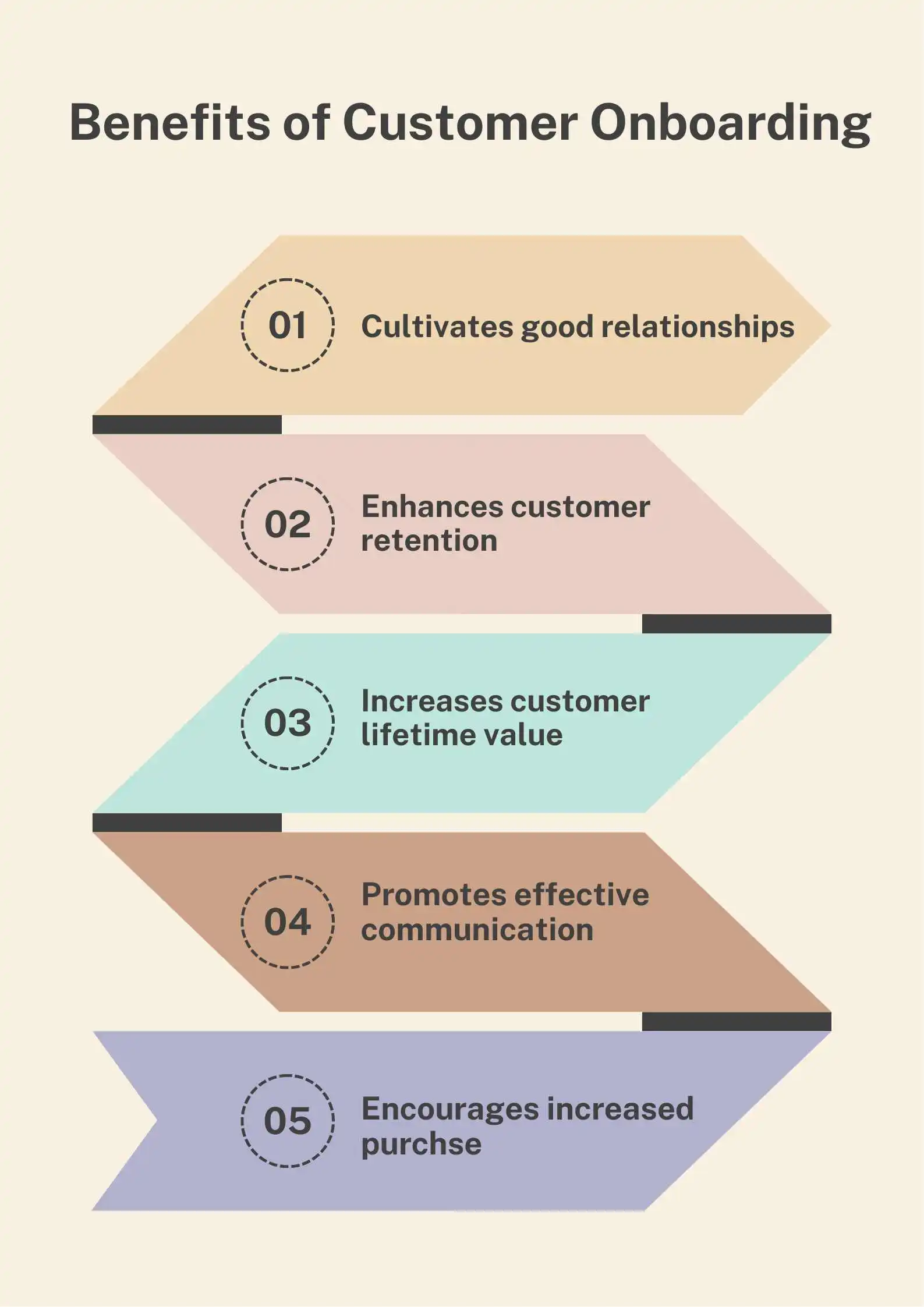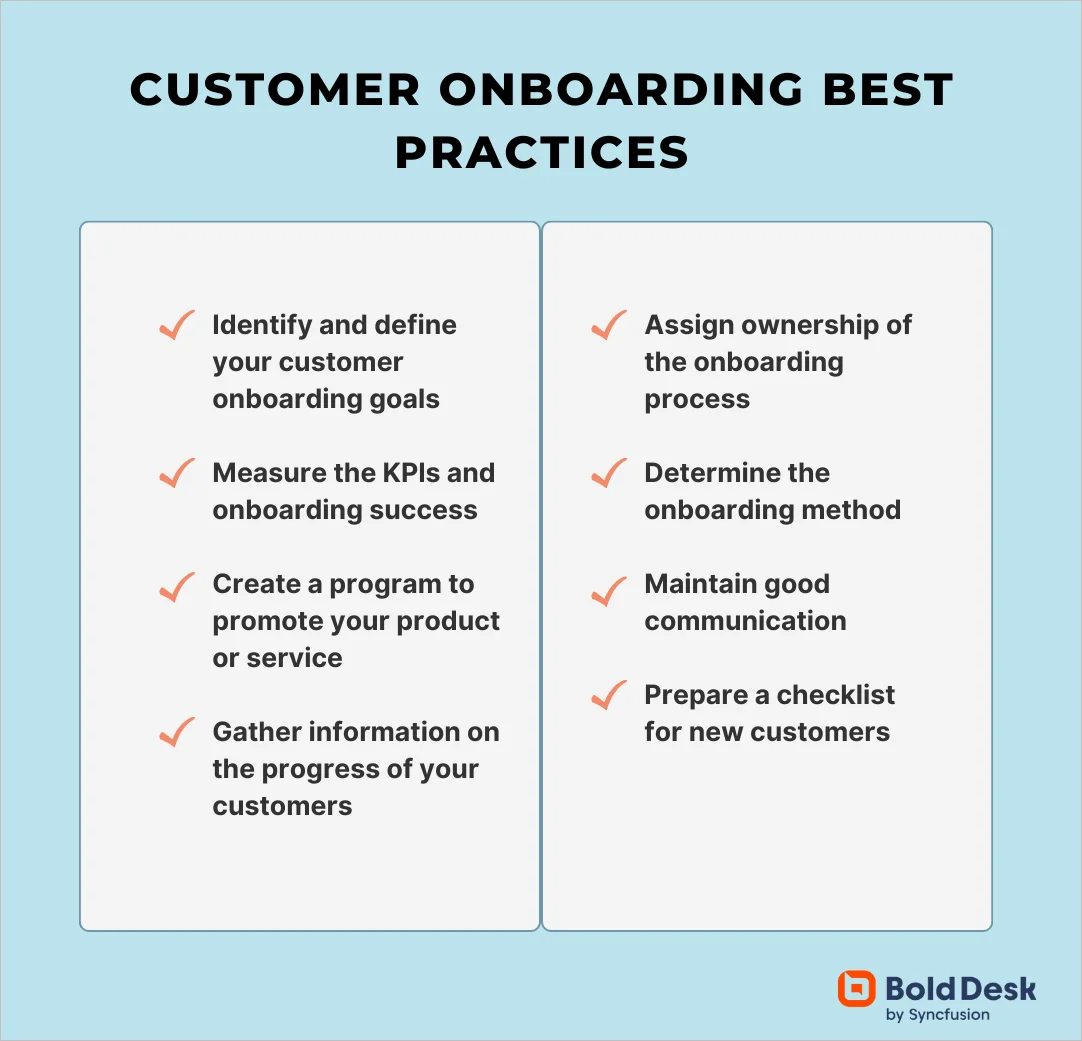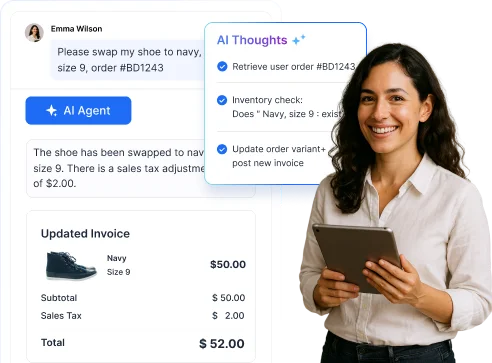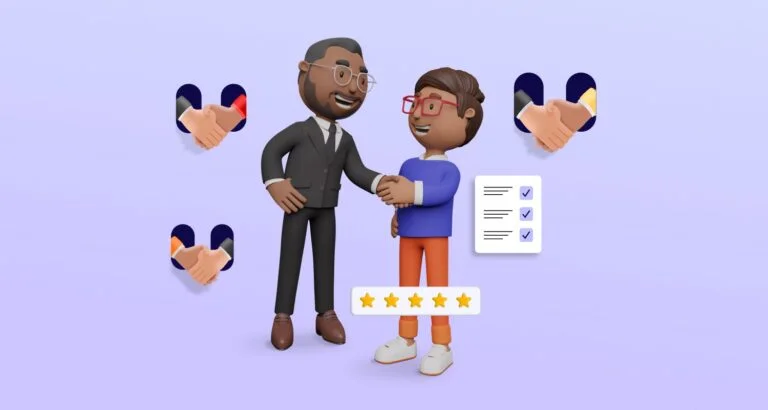Customers’ first impression of a company is hard to shake. If getting started with a new product or service is difficult and without guidance, they may decide to look elsewhere for an easier alternative.
According to Userpilot 74% of potential clients will switch to a competitor if the onboarding process is complicated.
Businesses should therefore ensure that new customers feel valued, guiding them through the details of various products or services, and answering questions.
Customer onboarding is a crucial process that can strengthen or shatter a company’s customer relationships.
In this post, we will discuss the onboarding process, the importance of client onboarding, and best practices for a customer onboarding strategy.
What is customer onboarding?
Customer onboarding is the process of taking new customers through the use of your product or service. This process helps customers understand key features and capabilities related to your products or services.
It encompasses the entire journey, from customers signing up to when they become fully accustomed to their purchase and are utilizing the product or service well.
According to UserGuiding, an effective onboarding process can increase customer retention rate by 50%.
Therefore, the customer onboarding process becomes a proven strategy for improving the overall customer engagement and ensuring long-term business success.
How to create a customer onboarding process
The onboarding process entails familiarizing new customers with a product or service they have signed up for or purchased and guiding them to maximize its benefits. The following are key steps for successful building a customer onboarding program.
Sign up your customers
The process of signing up is an important first step in the customer onboarding strategy. It entails customers making a formal commitment to use a particular product or service.
Customers can usually sign up for or purchase your products through:
- Your website
- Calling your customer service number
- Your physical store, if applicable
Welcoming customers
Once a customer has finalized a purchase or signed up for a service, it’s time to provide them with a warm and friendly welcome.
This can be achieved by either welcoming the customer in person or sending them a welcome message.
The welcoming email should contain:
- Appreciation for their patronage
- Information on how to get started
- Contact information for questions
A warm welcome not only adds a personal touch but also helps in building a solid relationship with your customers.
Product or service setup
During this phase, a company helps its customers initiate their journey with their product or service. A company’s support or dedicated onboarding team can guide customers through:
- Configuring their accounts
- Establishing data connections
- Personalizing their settings
- Showcasing how to access the main features of your product or service.
The product instructions can be done through tutorials, videos, customer onboarding checklists, and documentation until and unless the customer requires more complex aid.
A knowledge base with specific tips, techniques, best practices, and practical examples to enhance their product usage is a great link to provide.
Make customer service more interactive
The onboarding training can be more involved than prepared materials can cover in some cases. Also, there are always customers who run into issues.
Part of the onboarding process is allowing them to ask questions and give suggestions. Live demos and support can be offered as part of your new customer service.
Moreover, these interactions can be used to encourage customers to explore the company’s offerings and motivate them to uncover additional benefits and advantages that the product or service can provide.
Regular check-ins
Routine customer follow-up to check on their progress is a great practice during client onboarding, depending on the product. This can be done through emails.
The attention makes new customers feel a company’s genuine dedication to their success. Regular check-ins track progress, build relationships, and allow feedback.
They shape new customers’ perceptions of the organization.
Importance of customer onboarding
A smooth onboarding journey sets the tone for long-term business success.

Below are the main advantages of implementing a strong onboarding strategy.
- Establishes good relationships: The onboarding process is vital in building positive relationships with new clients and nurturing customer loyalty to a company, as it creates a positive and lasting impression.
- Improves customer retention: A strong onboarding process helps customers become comfortable and confident in using your product or service, which builds trust and satisfaction early on, encouraging them to continue engaging with the brand over time.
- Increases customer lifetime value: An effective onboarding process helps customers quickly understand and engage with a product or service, fostering a strong connection that encourages long-term loyalty and continued investment.
In fact, customer-centric organizations are 60% more profitable compared to companies that do not focus on their clients.
- Facilitates effective communication: The onboarding process offers opportunities to set up clear and efficient customer communication channels when they reach out to you with their queries and concerns. They’re more likely to take chances with your products if they know it’s easy to get help using them, which you prove in your onboarding.
- Creates opportunities for upselling and cross-selling: When customers are fully engaged and understand your product’s features and value through the onboarding process, they are more likely to consider exploring additional features or complementary services.
Best practices for a customer onboarding strategy
The onboarding process helps new users understand, engage with, and recognize the value of a product or service. Following are some customer onboarding best practices.

Identify and define your customer onboarding goals
What do we want to achieve with our onboarding process? That’s the first question a company should answer before designing theirs.
They should identify the objectives of the customers being introduced to the product or service and determine the onboarding’s expected outcome.
Setting goals during onboarding provides a clear direction and purpose.
Measure the KPIs and onboarding success
After setting your goals, measure the success of your onboarding process by tracking customer onboarding metrics such as:
- Time-to-Value (TTV)
- Activation Rate
- Customer Satisfaction
- Retention Rate
These customer service KPIs help you assess the effectiveness of your onboarding strategies and how changes you make influence that effectiveness.
Continuous analyzing of these customer success metrics helps in pinpointing areas that need improvement and ensures that your onboarding process meets objectives and drives business growth.
Create a customer onboarding program to promote your product or service
The first customer interaction with your product plays a pivotal role in determining their long-term engagement.
Therefore, businesses should aim to develop a program that motivates customers to utilize their product or service.
These digital customer onboarding programs may involve a series of tutorials, webinars, or even personalize training sessions to help customers understand and use your product effectively.
Just make sure you don’t overwhelm your customers. Start with the basics and offer more complex feature training once that’s mastered.
Gather information on the progress of your customers
Clearly understanding your customers’ progress with their new purchase lets you offer them appropriate and timely support when they need it.
To achieve this, collect data from all customer interactions, including:
- Support chats
- Support tickets
- Forum discussions
- Feedback surveys
Analyzing this information reveals where customers struggle during onboarding, enabling you to tailor materials and restructure the process for a better experience.
Additionally, training your support team to anticipate these challenges ensures a smoother customer journey.
Assign ownership of the onboarding process
You need to decide who will be responsible for overseeing all the onboarding materials and activities. This person or team will be responsible for organizing all onboarding tasks and guaranteeing a smooth operation.
Choosing the right person or team is important as it establishes accountability and the careful execution of the customer onboarding strategy.
Determine the onboarding method
Decide how best to conduct your onboarding process. For example, this can be done through personal training or online tutorials.
The chosen method should be designed to meet the specific needs and preference of the customers being onboarded, as well as the nature of your products.
Offering more than one option for learning can be beneficial if your customer base is varied.
Maintain good communication
The importance of effective communication in successfully onboarding individuals cannot be overstated.
Address their questions and concerns while updating them on new improvements, upcoming changes and how to prepare for them.
According to LinkedIn, poor communication during the customer onboarding process may result in 80% of customer churn.
Proactively notifying customers about improvements prevents confusion or frustration, especially when changes occur during their learning phase.
Direct communication, rather than relying on website announcements, ensures customers feel prepared and valued.
Prepare a clear customer onboarding checklist for new customers
A well-structured checklist for client onboarding aids in self-monitoring their progress through the training and ensures no step is overlooked.
The checklist may include tasks like:
- Setting up accounts
- Testing features
- Attending training sessions
- Reviewing policies and procedures
Client onboarding templates
Client onboarding templates can streamline the onboarding process, providing a smooth transition for new clients and establishing the foundation for a successful customer relationship.
Invitation email template
This is the initial email a new client will receive from you after registering for your service or product.
This email’s goal is to welcome the consumer to your business and give them all the information they need to get going.
Making a good first impression is crucial, so make sure this email is approachable, educational, and supportive. For example:
Customer onboarding invitation email template
Dear [Customer Name],
Welcome and thank you for choosing [Company Name]! We hope you will be happy about your choice.
We at [Your Company Name] always strive to provide the best for our clients. We should schedule a meeting to initiate your customer onboarding process.
Before we begin the session, kindly check out these resources to familiarize with your new [product or service]:
[Link to your self-service portal or documentation]
[Link to your customer service portal or form]
[Link to your online community forum]
[Link to your feedback portal]
Please reply to this email to let me know which dates and times work best for you for the onboarding meeting.
If you have any questions before then, feel free to reach out to our support team through [support Contact Information] for assistance.
I sincerely hope you enjoy our service.
Best regards,
[Your Name]
[Job Title].
Template for a customer intake form
A client intake form aids in obtaining necessary information about a new customer.
The form collects the information about the customer, their specific requirements, preferences, and contact details.
This template streamlines the collection process and ensures all essential information is gathered from the start.
Here is an example you can use:
Template for Customer Intake Form
Please fill out the following:
Personal information
Name:
Email:
Company name:
Job title:
Preferred contact method:
Product or service information
Product or service purchased:
Purchase date:
Reason for purchase:
Goals for using our brand:
Previous experience with similar products or services:
Additional information
How did you hear about us?
Do you have any questions or concerns?
Template for onboarding timeline
An onboarding timeline template is a formal schedule that outlines the key milestones and deadlines during the onboarding process.
It aids in informing both the company and the new customer about the expected time-frame.
This form includes the dates for the first meeting, training sessions, and evaluations.
For instance:
Onboarding Timeline Template
Welcome again to [Company]! In order to make your onboarding as smooth as possible, we have compiled a list and schedule of training courses, as discussed in our email correspondence.
The following is the onboarding training schedule we will follow:
Day 1: Introductory meeting with product expert.
• Introduction to the company policies and procedures.
• Introduction to the product or service.
Day 2: Product training session
• In-depth exploration of product features and their usage guide.
Day 3: Third training session
• Evaluation of user goals and objectives.
• Discussing achievable solutions to business success.
Day 4: Tracking progress and feedback
• Training on how to track your progress.
• Feedback regarding the customer onboarding experience.
Offer training resources
Assist new customers in understanding your company’s products and services by sending them a link to a comprehensive repository of training resources such as in a knowledge base.

These resources can include how-to guides, frequently asked questions (FAQs), and video tutorials.
By ensuring easy accessibility to these resources, clients can gain confidence and become more self-reliant in utilizing the company’s products.
Example template:
Repository of Training Resources
Welcome to our training resources repository!
Here, you’ll find:
• The [product] user guide
• Video tutorials
• FAQs
• Webinar recordings
• Support forums
Template for email handover to other departments
This customer onboarding email template is meant to be simple, direct, and educational. It gives the new clients an overview of the support department, outlines their responsibilities, and includes contact details.
By receiving this, the client knows who to contact for concerns or queries now that the onboarding phase is concluded.
To hand-over clients to other departments, you can use the following template:
Template for Departmental Customer Hand-over
Dear [Customer Name],
We sincerely hope you are satisfied with [Product]. We are dedicated to giving you the best service possible, and therefore, we would like to introduce you to our [Department Name].
[Shortly outline the department’s job] is the responsibility of the [Department Name] team. They will serve as your contact for [Name the problems or queries that the department deals with].
Contact the department through [Department Email Address] or [Department Contact Number].
Team members will be available [Name the hours of operation for the department]. We guarantee that you will receive the best service possible from our [Department Name] staff.
It’s been a pleasure serving you for your onboarding. We appreciate you selecting [Your Company’s Name]. We’re eager to provide you with better service.
Best Regards,
[Your Name].
Offer seamless customer onboarding experiences for success
Customers expect a smooth transition throughout their onboarding journey. A well-executed customer onboarding process helps customers become familiar and comfortable with your product or service, which enhances customer satisfaction and loyalty.
BoldDesk® offers a set of powerful features to enable you offer a streamlined customer onboarding process, such as a self-service knowledge base for clients to solve issues independently and customer satisfaction surveys to track onboarding effectiveness.
Initiate a 15-day free trial or schedule a live demo to explore BoldDesk features first-hand. For additional details, reach out to BoldDesk’s support team.
We hope this blog post was insightful. Do you have any additional comments or feedback? Please leave them in the comment section below!
Related articles
- 7 Best Techniques to Improve Customer Experience
- 8 Strategies to Provide Efficient Customer Service
- 5 Best Ways to Build and Organize a Customer Support Team
Frequently Asked Questions
The length of a customer onboarding process depends on your product’s complexity and customer goals. For most SaaS businesses, it typically takes a few days to a few weeks, with the main objective being to help customers reach their first success as quickly as possible.
The customer onboarding journey is divided into three stages:
- Primary: Focuses on helping clients understand the core value of the product.
- Secondary: Introducing more product features and benefits that will improve the overall experience.
- Tertiary: Dedicated to offering ongoing support and gathering feedback to enhance customer trust and build long-term engagement.
Customer onboarding tools make the process faster, more efficient, and personalized. Common options include CRM systems, product tour platforms like WalkMe or Userpilot, email automation tools, and analytics software to track engagement and success.
These tools help businesses scale onboarding without compromising quality.
Common mistakes in customer onboarding include overwhelming customers with too much information, failing to personalize the experience, ignoring feedback, and not setting clear expectations.
Avoiding these pitfalls ensures a smoother onboarding journey and stronger customer relationships.



















 Email Ticketing System
Email Ticketing System Shared Inbox Software
Shared Inbox Software Multi Brand Help Desk
Multi Brand Help Desk Internal Help Desk Software
Internal Help Desk Software Trouble Ticketing Software
Trouble Ticketing Software Mobile Help Desk
Mobile Help Desk 
















